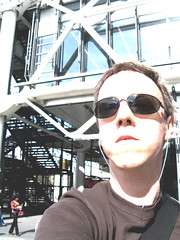Arty Party
I've just added a few photographs from last night's private view at the Margaret Street Art School in Birmingham to my Flickr stream. The consensus after the show (at least with those I asked) was that while the work itself was overall no better or worse than in previous years there's a feeling that the whole model for a show of student Fine Art work is running out of steam. Is it possible that what became true for us running Multimedia Design a few years ago is now becoming true for other disciplines? This year's Graphic Design showing seemed to reject the notion of individual student spaces, and it seemed a very out-of-date approach for Fine Art too.
It may be that much of contemporaneous student work deals with similar issues ('this year's meme'?) and that there are common points of reference in form too. This year video imagery featured heavily: LCD screens, projections, pixels adorned the most unlikely pieces. These similarities contrast the strict serialisation of individuals' displays, and make a thematic structuring difficult; at odds with media-based arrangement. Perhaps it's time for undergraduate Artists to begin collaborating more fully, locating work appropriately, and for the department to begin treating the show as a starting point for and a representational sample of the sort of critical and practical debate that's at work within their institution. The old way of doing things doesn't seem to offer much in the way of exciting future possibility, nor much of an incentive for excited young individuals to join us.

